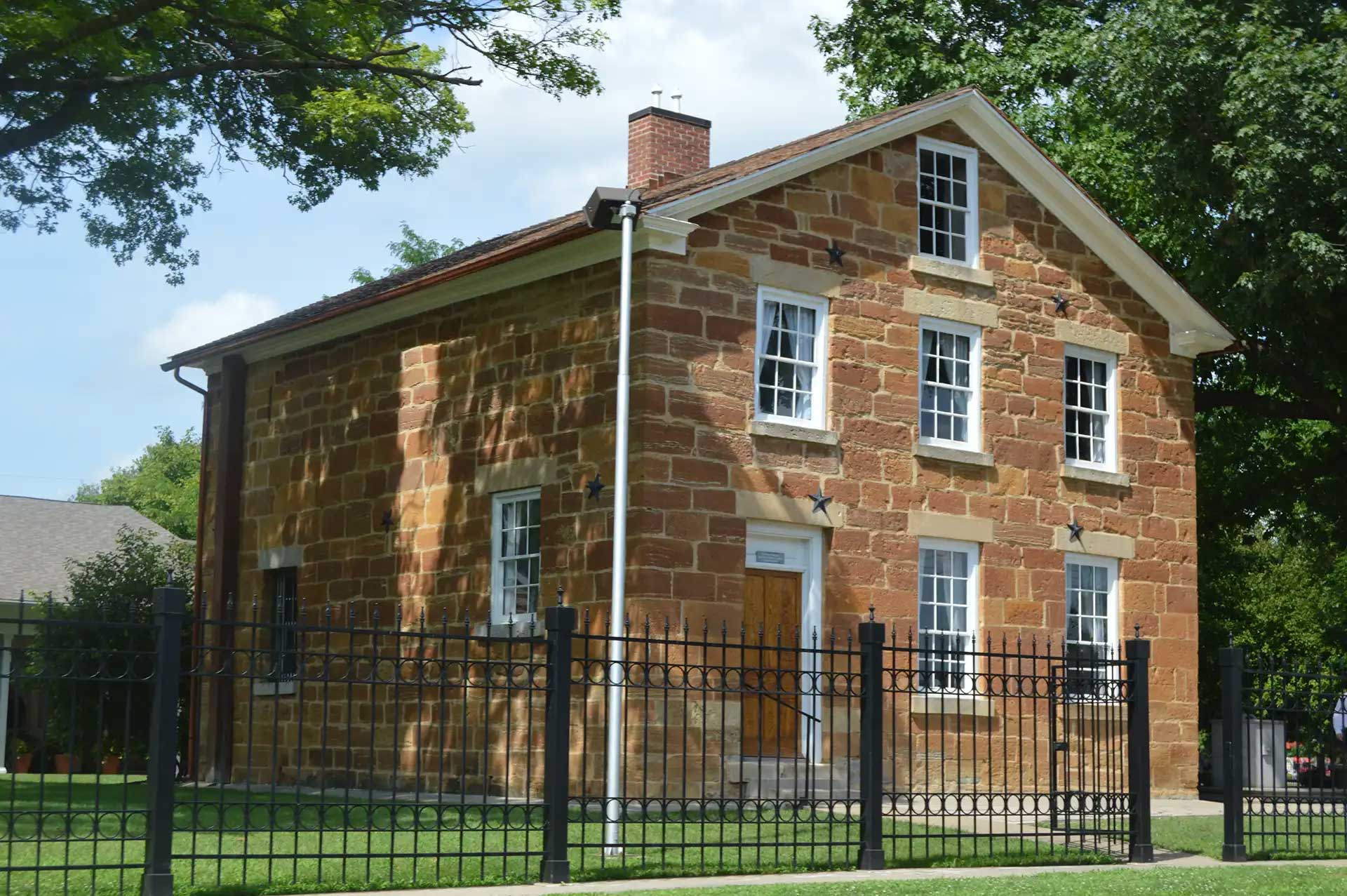You are here
Book of Mormon Central is in the process of migrating to our new Scripture Central website.
We ask for your patience during this transition. Over the coming weeks, all pages of bookofmormoncentral.org will be redirected to their corresponding page on scripturecentral.org, resulting in minimal disruption.

D&C 135–136
New from BMC
Watch videos from Gospel scholars and teachers to learn more about these sections of the Doctrine and Covenants. Book of Mormon Central produces weekly videos from Tyler Griffin, Taylor Halverson, John Hilton III, Anthony Sweat, Casey Griffiths, Stephanie Dibb Sorensen and Marianna Richardson. Read commentaries and other resources from KnoWhys, Steven C. Harper, Casey Griffiths, and Susan Easton Black.
Videos
Doctrine and Covenants 135
Doctrine and Covenants 136
Daily Reading Plan
Structure your personal scripture study by following a 15-minute, day-by-day plan. Each day's assignment includes the required scripture passages from the Come, Follow Me curriculum, as well as suggestions for additional resources to bring context and understanding to your study. For the best experience, use our Reading Plan in the free ScripturePlus app! You can track your progress and have access to the best resources.
Monday
- Commentary: Section 135 Context, Steven C. Harper
- Scripture: D&C 135:1–3
- Commentary: Casey Paul Griffiths, Doctrine and Covenants Minute, Doctrine and Covenants 135:1–2.
- Commentary: Casey Paul Griffiths, Doctrine and Covenants Minute, Doctrine and Covenants 135:3.
Tuesday
- Scripture: D&C 135:4–5
- Commentary: Casey Paul Griffiths, Doctrine and Covenants Minute, Doctrine and Covenants 135:4–5.
-
Quote: How should we respond to a sincere inquirer who is concerned about negative comments he or she has heard or read about the Prophet Joseph Smith? Of course, we always welcome honest and genuine questions.
To questions about Joseph’s character, we might share the words of thousands who knew him personally and who gave their lives for the work he helped establish. John Taylor, who was shot four times by the mob that killed Joseph, would later declare: “I testify before God, angels, and men, that [Joseph] was a good, honorable, [and] virtuous man— … [and] that his private and public character was unimpeachable—and that he lived and died as a man of God” (D&C 135:3).
Neil L. Andersen, “Joseph Smith,” October 2014 General Conference. -
Quote: I think one of the sweetest lessons taught by the Prophet Joseph, and yet one of the saddest, occurred close to the time of his death. He had seen in vision the Saints leaving Nauvoo and going to the Rocky Mountains. He was anxious that his people be led away from their tormentors and into this promised land which the Lord had shown him. He no doubt longed to be with them. However, he had been issued an arrest warrant on trumped up charges. Despite many appeals to Governor Ford, the charges were not dismissed. Joseph left his home, his wife, his family, and his people and gave himself up to the civil authorities, knowing he would probably never return.
These are the words he spoke as he journeyed to Carthage: “I am going like a lamb to the slaughter; but I am calm as a summer’s morning; I have a conscience void of offense towards God, and towards all men” (D&C 135:4).
Thomas S. Monson, “The Prophet Joseph Smith: Teacher by Example,” October 2005 General Conference. -
Quote: We see an example of individual peace amidst strife and contention in the life of the Prophet Joseph Smith. Near the end of his life, he was at the center of a whirlwind of turmoil and tribulation caused by devious associates, false accusations, and cunning plots against his life. Yet a few days before his death, he said, “I am calm as a summer’s morning; I have a conscience void of offense towards God, and towards all men” (D&C 135:4). His inner peace sustained him through monumental adversities, even his own martyrdom.
Peace is more than a lofty ideal. It is a practical principle that, with conscious effort, can become a normal part of our lives as we deal with matters both large and small. One habit that prevents inner peace is procrastination. It clutters our minds with unfinished business and makes us uneasy until we finish a task and get it out of the way. We are at peace in our Church callings when we do the work at the proper time instead of waiting until the last possible moment. This is true of going to the temple often, performing our home teaching and visiting teaching assignments, preparing lessons and talks, and doing other assignments.
Joseph B. Wirthlin, “Peace Within,” April 1991 General Conference.
Wednesday
- Scripture: D&C 135:6–7
- Commentary: Casey Paul Griffiths, Doctrine and Covenants Minute, Doctrine and Covenants 135:6–7.
-
Quote: Today we have three new books of scripture: the Book of Mormon, the Doctrine and Covenants, and the Pearl of Great Price. I love all of these sacred volumes. This afternoon I would like to speak particularly about the Book of Mormon and the Doctrine and Covenants. These two great books of latter-day scripture are bound together as revelations from Israel’s God for the purpose of gathering and preparing His people for the second coming of the Lord. As President John Taylor wrote, the bringing forth of these two sacred volumes “cost the best blood of the nineteenth century” (D&C 135:6) namely the lives of the Prophet Joseph Smith and his brother Hyrum.
Ezra Taft Benson, “The Gift of Modern Revelation,” October 1986 General Conference. - Video:
Thursday
- Commentary: Section 136 Context, Steven C. Harper
- Scripture: D&C 136:1–18
- Commentary: Casey Paul Griffiths, Doctrine and Covenants Minute, Doctrine and Covenants 136:1–4.
- Commentary: Casey Paul Griffiths, Doctrine and Covenants Minute, Doctrine and Covenants 136:5–11.
Friday
- Scripture: D&C 136:19–27
- Commentary: Casey Paul Griffiths, Doctrine and Covenants Minute, Doctrine and Covenants 136:12–27.
-
Quote: To those of you who so suffer and who, nevertheless, so endure and so testify by the eloquence of your examples, we salute you in Christ! Please forgive those of us who clumsily try to comfort you. We know from whence your true comfort comes. God’s “bosom” is there to be leaned upon.
Jesus’ promised peace is a special form of rest amid unrest. Even when other things are in commotion, His disciples can still stand (see D&C 45:26, 32). His disciples know the Lord is there in latter-days. “I am he who led the children of Israel out of the land of Egypt; and my arm is stretched out in the last days, to save my people Israel” (D&C 136:22).
Neal A. Maxwell, “Yet Thou Art There,” October 1987 General Conference. -
Quote: My beloved brothers and sisters, I testify that forgiving and forsaking offenses, old or new, is central to the grandeur of the Atonement of Jesus Christ. I testify that ultimately such spiritual repair can come only from our divine Redeemer, He who rushes to our aid “with healing in his wings.” (Malachi 4:2) We thank Him, and our Heavenly Father who sent Him, that renewal and rebirth, a future free from old sorrows and past mistakes, are not only possible, but they have already been purchased, paid for, at an excruciating cost symbolized by the blood of the Lamb who shed it.
With the apostolic authority granted me by the Savior of the world, I testify of the tranquility to the soul that reconciliation with God and each other will bring if we are meek and courageous enough to pursue it. “Cease to contend one with another,” the Savior pled (D&C 136:23). If you know of an old injury, repair it. Care for one another in love.
Jeffrey R. Holland, “The Ministry of Reconciliation,” October 2018 General Conference.
Saturday
- Scripture: D&C 136:28–32
- Commentary: Casey Paul Griffiths, Doctrine and Covenants Minute, Doctrine and Covenants 136:28–33.
-
Quote: Modern revelation reaffirms the importance of sacred music. In one of the earliest revelations given through the Prophet Joseph Smith, the Lord appointed Emma Smith “to make a selection of sacred hymns, as it shall be given thee, which is pleasing unto me, to be had in my church.
“For my soul delighteth in the song of the heart; yea, the song of the righteous is a prayer unto me, and it shall be answered with a blessing upon their heads” (D&C 25:11–12).
In a revelation given through another prophet a generation later, the Lord commanded his people to “praise the Lord with singing, [and] with music” (D&C 136:28).
This direction to praise the Lord with singing is not limited to large meetings. When the Lord’s Apostles meet in modern times, the singing of hymns is still part of their meetings. The weekly meetings of the First Presidency and Quorum of the Twelve Apostles in the Salt Lake Temple always begin with a hymn. Elder Russell M. Nelson plays the organ accompaniment. The First Presidency, who conduct these meetings, rotate the privilege of selecting the opening song. Most of us record the date each hymn is sung. According to my records, the opening song most frequently sung during the decade of my participation has been “I Need Thee Every Hour” (Hymns, 1985, no. 98). Picture the spiritual impact of a handful of the Lord’s servants singing that song before praying for his guidance in fulfilling their mighty responsibilities.
Dallin H. Oaks, “Worship through Music,” October 1994 General Conference. -
Quote: President Howard W. Hunter once said, “God knows what we do not know and sees what we do not see.” None of us knows the wisdom of the Lord. We do not know in advance exactly how He would get us from where we are to where we need to be, but He does offer us broad outlines in our patriarchal blessings. We encounter many bumps, bends, and forks in the road of life that leads to the eternities. There is so much teaching and correction as we travel on that road. Said the Lord, “He that will not bear chastisement is not worthy of my kingdom” (D&C 136:31). “For whom the Lord loveth he chasteneth” (Heb. 12:6).
As we live on earth we must walk in faith, nothing doubting. When the journey becomes seemingly unbearable, we can take comfort in the words of the Lord: “I have heard thy prayer, I have seen thy tears: behold, I will heal thee” (2 Kgs. 20:5). Some of the healing may take place in another world. We may never know why some things happen in this life. The reason for some of our suffering is known only to the Lord.
James E. Faust, “Where Do I Make My Stand?”, October 2004 General Conference. -
Quote: As we strive for worthiness, a scripture we should not lose sight of is Doctrine and Covenants, section 136, verse 31: “He that will not bear chastisement is not worthy of [the Lord’s] kingdom” (D&C 136:31). Sometimes there is a great need for us to be chastised, disciplined, and corrected in a spirit of love, help, and hope. Guidance and suggestions should be offered in a loving way, but most of us have a tendency to rebel or be dismayed when someone suggests that our conduct is less than it should be. As Benjamin Franklin once said: “Those things that hurt, instruct. It is for this reason that wise people learn not to dread but welcome problems.”
In life there are requirements for almost all privileges—education demands them, business has its regulations, sports and games have their rules, the Church has certain standards, and so on. But in every case there is help to meet those requirements. It is up to us to look for that assistance so we can understand the rules and strengthen ourselves as we receive direction from the sources available. It is not wise or proper for us to judge ourselves as being unworthy and thus stop our progress.
When we dwell on our own weaknesses, it is easy to dwell on the feelings that we are unworthy. Somehow we need to bridge the gap between continually striving to improve and yet not feeling defeated when our actions aren’t perfect all the time. We need to remove unworthy from our vocabulary and replace it with hope and work. This we can do if we turn to quieter, deeper, surer guidelines—the words of our prophets and leaders, past and present.
Marvin J. Ashton, “On Being Worthy” April 1989 General Conference.
Sunday
- Scripture: D&C 136:33–42
- Commentary: Casey Paul Griffiths, Doctrine and Covenants Minute, Doctrine and Covenants 136:34–42.
- Video: (Casey)
Bibliography
Doctrine and Covenants 135
Steven C. Harper, “Section 135,” Doctrine and Covenants Contexts (Springville, UT: Book of Mormon Central, 2021), 362–364.
Susan Easton Black, “The Martyrdom - Insight Into D&C 135,” Restoration Voices Volume 2: Insights and Stories of the Doctrine and Covenants (Springville, UT: Book of Mormon Central, 2021).
Jeffrey Mahas, “Remembering the Martyrdom,” Revelations in Context: The Stories Behind the Sections of the Doctrine and Covenants. Salt Lake City, UT: The Church of Jesus Christ of Latter-day Saints, 2016.
“A Lamb to the Slaughter,” Saints, Volume 1: The Standard of Truth (Salt Lake City, UT: The Church of Jesus Christ of Latter-day Saints, 2018), 1:539–543.
“Deaths of Joseph and Hyrum Smith,” Church History Topics.
“Nauvoo Expositor,” Church History Topics.
“Settlement of Joseph Smith's Estate,” Church History Topics.
“Succession of Church Leadership,” Church History Topics.
Andrew H. Hedges, “Joseph Smith, Robert Foster, and Chauncey and Francis Higbee,” Religious Educator 18, no. 1 (2017): 88–111.
Richard Neitzel Holzapfel, “The Prophet’s Final Charge to the Twelve, 1844,” in Joseph Smith, the Prophet and Seer, ed. Richard Neitzel Holzapfel and Kent P. Jackson (Provo, UT: Religious Studies Center, Brigham Young University; Salt Lake City: Deseret Book, 2010), 495–524.
Robert L. Millet, “Joseph Smith Among the Prophets,” in Joseph Smith: The Prophet, The Man, ed. Susan Easton Black and Charles D. Tate Jr. (Provo, UT: Religious Studies Center, Brigham Young University, 1993), 15–31.
Jeni Broberg Holzapfel and Richard Neitzel Holzapfel, eds., “Scenes in Nauvoo after the Martyrdom of the Prophet and Patriarch,” A Woman’s View: Helen Mar Whitney’s Reminiscences of Early Church History (Provo, UT: Religious Studies Center, Brigham Young University, 1997), 241–267.
Book of Mormon Central. “What Does It Mean to Be a Martyr? (Ether 12:37, 39).” KnoWhy 1 (January 1, 2016)
Book of Mormon Central, “Why Does God Sometimes Allow His Saints to Be Martyred? (Alma 14:11),” KnoWhy 351 (August 11, 2017).
D&C 135:1
Susan Easton Black, “Joseph Smith Jr.,” Restoration Voices Volume 1: People of the Doctrine and Covenants (Springville, UT: Book of Mormon Central, 2021).
Susan Easton Black, “Hyrum Smith,” Restoration Voices Volume 1: People of the Doctrine and Covenants (Springville, UT: Book of Mormon Central, 2021).
Sharon Anderson, “Offering in June,” in Praising the Prophet: Joseph Smith and the Restoration in History and Verse (Orem, UT: Time-Lines Etc., 2005), 82.
D&C 135:2
Susan Easton Black, “John Taylor,” Restoration Voices Volume 1: People of the Doctrine and Covenants (Springville, UT: Book of Mormon Central, 2021).
Susan Easton Black, “Willard Richards,” Restoration Voices Volume 1: People of the Doctrine and Covenants (Springville, UT: Book of Mormon Central, 2021).
D&C 135:3
Book of Mormon Central. “Why is a Seer Greater than a Prophet? (Mosiah 8:15).” KnoWhy 86 (April 26, 2016).
Book of Mormon Central, “Why Did Nephi Connect Isaiah’s Prophecies with Joseph Who Was Sold into Egypt? (2 Nephi 25:17),” KnoWhy 375 (October 24, 2017).
Book of Mormon Central, “What Does the Book of Mormon Teach about Prophets? (Helaman 13:4),” KnoWhy 284 (March 8, 2017).
Sharon Anderson, “Prophet, Seer, and Revelator,” in The Glory of the Son (Orem, UT: Time-Lines Etc., 2019), 67.
D&C 135:5
Book of Mormon Central, “What Does It Really Mean to Have Charity? (Moroni 7:45),” KnoWhy 361 (September 5, 2017).
Doctrine and Covenants 136
Steven C. Harper, “Section 136,” Doctrine and Covenants Contexts (Springville, UT: Book of Mormon Central, 2021), 365–368.
Susan Easton Black, “The Pioneers - Insight Into D&C 136,” Restoration Voices Volume 2: Insights and Stories of the Doctrine and Covenants (Springville, UT: Book of Mormon Central, 2021).
Susan Easton Black, “Brigham Young,” Restoration Voices Volume 1: People of the Doctrine and Covenants (Springville, UT: Book of Mormon Central, 2021).
Jeffrey Mahas, “This Shall Be Our Covenant,” Revelations in Context: The Stories Behind the Sections of the Doctrine and Covenants. Salt Lake City, UT: The Church of Jesus Christ of Latter-day Saints, 2016.
“Word and Will of the Lord,” Saints, Volume 2: No Unhallowed Hand (Salt Lake City, UT: The Church of Jesus Christ of Latter-day Saints, 2020), 2:46–48.
“Departure from Nauvoo,” Church History Topics.
“Pioneer Trek,” Church History Topics.
“Succession of Church Leadership,” Church History Topics.
Ronald W. Walker, “Six Days in August: Brigham Young and the Succession,” in A Firm Foundation: Church Organization and Administration, ed. David J. Whittaker and Arnold K. Garr (Provo, UT: Religious Studies Center, Brigham Young University; Salt Lake City: Deseret Book, 2011), 161–96.
Chad M. Orton, “’This Shall Be Our Covenant’: Brigahm Young and D&C 136,” Religious Educator 19, no. 2 (2018): 119–51.
Wendy Top, “’The Poorest of the Poor and the Sickest of the Sick’: The Luman Andros Shurtliff Poor Camp Rescue,” in Far Away in the West: Reflections on the Mormon Pioneer Trail, edited by Scott C. Esplin, Richard E. Bennett, Susan Easton Black, and Craig K. Manscill (Provo, UT: Religious Studies Center; Salt Lake City: Deseret Book, 2015), 81–97.
Book of Mormon Central, “How Did Brigham Young Help Take the Book of Mormon to the World? (1 Nephi 5:18),” KnoWhy 354 (August 18, 2017).
Book of Mormon Central, “How Was Lehi’s Journey Similar to the Mormon Pioneers’ Trek West? (1 Nephi 2:20),” KnoWhy 357 (August 25, 2017).
D&C 136:1
Sharon Anderson, “Exodus from Nauvoo,” in The Glory of the Son (Orem, UT: Time-Lines Etc., 2019), 58.
Sharon Anderson, “Montrose Miracle,” in The Glory of the Son (Orem, UT: Time-Lines Etc., 2019), 60.
Sharon Anderson, “Traveling Light,” in The Glory of the Son (Orem, UT: Time-Lines Etc., 2019), 62.
D&C 136:12
Susan Easton Black, “Ezra T. Benson,” Restoration Voices Volume 1: People of the Doctrine and Covenants (Springville, UT: Book of Mormon Central, 2021).
Susan Easton Black, “Erastus Snow,” Restoration Voices Volume 1: People of the Doctrine and Covenants (Springville, UT: Book of Mormon Central, 2021).
D&C 136:13
Susan Easton Black, “Orson Pratt,” Restoration Voices Volume 1: People of the Doctrine and Covenants (Springville, UT: Book of Mormon Central, 2021).
Susan Easton Black, “Wilford Woodruff,” Restoration Voices Volume 1: People of the Doctrine and Covenants (Springville, UT: Book of Mormon Central, 2021).
D&C 136:14
Susan Easton Black, “Amasa Mason Lyman,” Restoration Voices Volume 1: People of the Doctrine and Covenants (Springville, UT: Book of Mormon Central, 2021).
Susan Easton Black, “George A. Smith,” Restoration Voices Volume 1: People of the Doctrine and Covenants (Springville, UT: Book of Mormon Central, 2021).
D&C 136:21–22
Book of Mormon Central, “Why is the Lord's Hand "Stretched Out Still"? (2 Nephi 19:12),” KnoWhy 49 (March 8, 2016).
Sharon Anderson, “The House of God,” in The Glory of the Son (Orem, UT: Time-Lines Etc., 2019), 13.
Sharon Anderson, “Israel Remembers,” in The Glory of the Son (Orem, UT: Time-Lines Etc., 2019), 86.
Sharon Anderson, “Leaving Egypt,” in The Glory of the Son (Orem, UT: Time-Lines Etc., 2019), 17.
D&C 136:36–42
Book of Mormon Central, “Why Does God Sometimes Allow His Saints to Be Martyred? (Alma 14:11),” KnoWhy 351 (August 11, 2017).
Sharon Anderson, “Voice of the Conference,” in The Glory of the Son (Orem, UT: Time-Lines Etc., 2019), 68.










